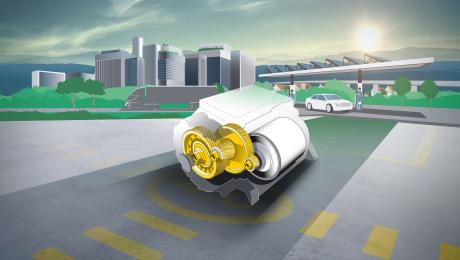Gear solutions for e-mobility

New drive technologies in electric mobility are changing the requirements for gears and therefore also for of the quality of the tooth flank surfaces. Manufacturers of gears have to adapt their manufacturing process accordingly. It’s good to be able to rely on a technology partner with expertise covering the entire range of production processes and technologies, which enables them to find suitable solutions even for special challenges.
E-mobility is changing the entire drivetrain in cars, which also changes the demands made of gear components. One of the most important topics is the reduction of noise emissions from the drivetrain while driving. In order to minimize installation space, many parts of the gearbox are manufactured using a lightweight or compact design. At the same time, gear components must become increasingly robust and long-lasting in order to withstand the considerable stress caused by the higher engine RPM.
Process and technology expertise from Liebherr
This results in high quality demands on the tooth flank surfaces, which in turn brings about growing demands on the gear cutting process. Liebherr-Verzahntechnik GmbH has addressed this issue and refined and optimized various technological solutions for e-gearboxes. “We know about the challenges that manufacturers and suppliers must master in terms of quality and process reliability”, explains Dr. Andreas Mehr, who is responsible for the technology applications of gear grinding and shaping. “We apply our expertise both in the process depth and in the range of technologies. This means that we can advise and assist customers comprehensively in order to find the optimal solution for them and their application.”
Processes and methods
On the process side, generating grinding with dressing-free CBN grinding worms, for example, ensures a high degree of process reliability. During the hard gear finishing, the gears can be precision-ground and polished, which further improves the surface roughness. Tools with small outside diameters machine collision-critical gears with limited tool overrun.
Methods for tooth lead modification are available for the tooth flank topology. For example, topologically error-free grinding with targeted end relief (GER) optimizes the load-bearing capacity. In order to reduce noise emissions, a targeted waviness can be applied to the tooth flank (Noise Excitation Optimization), or the diagonal amount during finishing can be increased in order to distribute the ghost line structure stochastically (Silent Shift Grinding).
... Read more on our homepage under "More info".

New drive technologies in electric mobility are changing the requirements for gears and therefore also for of the quality of the tooth flank surfaces. Manufacturers of gears have to adapt their manufacturing process accordingly. It’s good to be able to rely on a technology partner with expertise covering the entire range of production processes and technologies, which enables them to find suitable solutions even for special challenges.
E-mobility is changing the entire drivetrain in cars, which also changes the demands made of gear components. One of the most important topics is the reduction of noise emissions from the drivetrain while driving. In order to minimize installation space, many parts of the gearbox are manufactured using a lightweight or compact design. At the same time, gear components must become increasingly robust and long-lasting in order to withstand the considerable stress caused by the higher engine RPM.
Process and technology expertise from Liebherr
This results in high quality demands on the tooth flank surfaces, which in turn brings about growing demands on the gear cutting process. Liebherr-Verzahntechnik GmbH has addressed this issue and refined and optimized various technological solutions for e-gearboxes. “We know about the challenges that manufacturers and suppliers must master in terms of quality and process reliability”, explains Dr. Andreas Mehr, who is responsible for the technology applications of gear grinding and shaping. “We apply our expertise both in the process depth and in the range of technologies. This means that we can advise and assist customers comprehensively in order to find the optimal solution for them and their application.”
Processes and methods
On the process side, generating grinding with dressing-free CBN grinding worms, for example, ensures a high degree of process reliability. During the hard gear finishing, the gears can be precision-ground and polished, which further improves the surface roughness. Tools with small outside diameters machine collision-critical gears with limited tool overrun.
Methods for tooth lead modification are available for the tooth flank topology. For example, topologically error-free grinding with targeted end relief (GER) optimizes the load-bearing capacity. In order to reduce noise emissions, a targeted waviness can be applied to the tooth flank (Noise Excitation Optimization), or the diagonal amount during finishing can be increased in order to distribute the ghost line structure stochastically (Silent Shift Grinding).
... Read more on our homepage under "More info".


